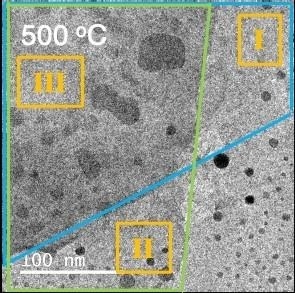Researchers from the Department of Energy’s SLAC National Accelerator Laboratory, Stanford University, and the Lawrence Berkeley National Laboratory (LBNL) created a twisted multilayer crystal structure for the first time and assessed its critical features. The twisted structure might aid researchers in creating next-generation materials for solar cells, quantum computers, lasers, and other technologies.
 The MoS2 layers and gold nanodiscs together heated up to 500 degrees Celsius. The three marked regions – I, II, and III – indicate the various layers of the sample. Region I shows gold on the bottom MoS2 layer; II shows Au below the top MoS2 layer; and III shows the gold between the top and bottom MoS2 layers. The gold nanodiscs are the darker regions in the region III. Image Credit: Yi Cui/Stanford University
The MoS2 layers and gold nanodiscs together heated up to 500 degrees Celsius. The three marked regions – I, II, and III – indicate the various layers of the sample. Region I shows gold on the bottom MoS2 layer; II shows Au below the top MoS2 layer; and III shows the gold between the top and bottom MoS2 layers. The gold nanodiscs are the darker regions in the region III. Image Credit: Yi Cui/Stanford University
This structure is something that we have not seen before – it was a huge surprise to me. A new quantum electronic property could appear within this three-layer twisted structure in future experiments.
Yi Cui, Study Co-Author and Professor, Stanford University and SLAC National Accelerator Laboratory
Adding Layers With a Twist
The crystals created by the scientists expanded on the notion of epitaxy, which happens when one type of crystal material develops on top of another in an orderly manner-similar to growing a nice lawn on top of dirt, but at the atomic level. Understanding epitaxial growth has been crucial to developing several sectors, most notably the semiconductor industry, for over 50 years.
Indeed, epitaxy is used in many of the electrical equipment we use today, including mobile phones, computers, and solar panels, to allow energy to flow and not flow through them.
To date, epitaxy research has concentrated on growing one layer of material on top of another, with the two materials sharing the same crystal orientation at the interface. For decades, this strategy has proven successful in various applications, including transistors, light-emitting diodes, lasers, and quantum devices.
However, to identify novel materials that perform even better for more demanding demands, such as quantum computing, researchers are looking for different epitaxial designs that may be more complicated but perform better, as illustrated by the “twisted epitaxy” notion in this work.
In their experiment, published in Science, researchers sandwiched a layer of gold between two sheets of molybdenum disulfide (MoS2). Because the top and bottom sheets were orientated differently, the gold atoms were unable to align with both at the same time, causing the Au structure to twist, according to Yi Cui, Professor Cui’s doctoral student in materials science and engineering at Stanford and the study's co-author.
With only a bottom MoS2 layer, the gold is happy to align with it, so no twist happens. But with two twisted MoS2 sheets, the gold is not sure to align with the top or bottom layer. We managed to help the gold solve its confusion and discovered a relationship between the orientation of Au and the twist angle of bilayer MoS2.
Yi Cui, Study Co-Author and Graduate Student, Stanford University
Zapping Gold Nanodiscs
To analyze the gold layer in depth, researchers from the Stanford Institute for Materials and Energy Sciences (SIMES) and LBNL heated a sample of the entire structure to 500 degrees Celsius. Then, using a method known as transmission electron microscopy (TEM), scientists transmitted electrons through the sample, revealing the shape, orientation, and strain of the gold nanodiscs after annealing at various temperatures.
Measuring the characteristics of the gold nanodiscs was an essential first step toward understanding how the novel structure could be created for real-world applications.
Cui added, “Without this study, we would not know if twisting an epitaxial layer of metal on top of a semiconductor was even possible. Measuring the complete three-layer structure with electron microscopy confirmed that it was not only possible, but also that the new structure could be controlled in exciting ways.”
Next, researchers want to use TEM to investigate the optical characteristics of gold nanodiscs and see whether their design affects physical aspects such as Au band structure. They also intend to expand this notion by attempting to construct three-layer structures using different semiconductor materials and metals.
We are beginning to explore whether only this combination of materials allows this or if it happens more broadly. This discovery is opening a whole new series of experiments that we can try. We could be on our way to finding brand new material properties that we could exploit.
Bob Sinclair, Study Co-Author and Charles M. Pigott Professor, School of Materials Science and Engineering, Stanford University
The study was funded by the DOE Office of Science’s Basic Energy Sciences.
Journal Reference:
Cui, Y., et. al. (2024) Twisted epitaxy of gold nanodisks grown between twisted substrate layers of molybdenum disulfide. Science. doi:10.1126/science.adk5947